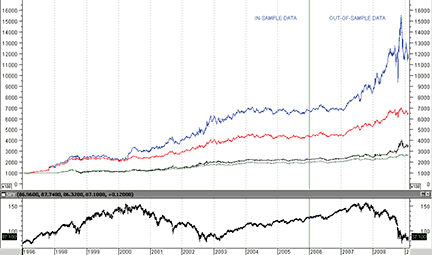TRADING TECHNIQUES
Do-It-Yourself Stratagems
Developing My Trading Strategy
Are the risks and returns involved in a more active investment style compatible with your resources and financial goals? Hereís a trading approach that can help answer your questions.
Entry in my mental trading journal, circa October 2008: The demise of buy & hope investing (and ensuing losses in my portfolio) is the nudge I need to finally consider developing a trading strategy in which I would have enough confidence to take some smarter risks. The first question I should ask myself is, “Are the risks and returns involved in a more active investment style compatible with my resources and financial goals?” Maybe. All I know is that I could do much better than buy & hold. But how? I havenít been able to sort through the cacophony of analysts, pundits, and stockpickers. I just know I need a more objective, systematic approach to investing.
I have been a casual student of technical analysis for a few years and am finally convinced it is the investing approach that best fits my personality and probably the healthiest for my wallet going forward. Do I have everything I need? Letís see:
- Magazines about technical analysis?

- Books about technical analysis?

- Bookmarked technical analysis websites?

- Technical analysisĖbased software?

Letís see what I can do.
Starting anew
Six months and many dollars later, my portfolio has been purged. Clean slate: My first decision was to choose a new set of securities to focus on. Liquidity, research and media coverage, ease of accounting and trade execution, ability to trade from the short side, and my own familiarity with the asset class and sector and availability of quality data were my main criteria. With this wishlist in mind, I narrowed my choices down to some exchange traded funds (Etfs): Spy, Qqqq, Iwm, Ief, and Ewz. I will start with Spy alone, as opposed to a portfolio. Trading on a portfolio basis adds exponential complexity to strategy-building, not the least because of correlation and money management issues. Not for me. Not this time.
I have a full-time job and cannot afford to trade for my account on intraday price action, so my periodicity is daily. Next step: find or develop a technical, rules-based system with potential for good future risk-adjusted returns.
Over the past few months, I have kept a cheat sheet of systems I have come across that seemed promising and sound enough to warrant further research & development. One of them is the J2L system, which is credited to Jean-Louis Lepreux (if you are reading this, Mr. Lepreux, thank you!). My goal is not to recommend this system or that, but simply to share the process through which I went to develop a trading strategy for myself.

Figure 1: equity curves for all systems. The equity curve for the basic system (top-most curve) looks like it has potential. For the most part, the curve is upward-sloping and equity growth is acceptable during the out-of-sample period.
At this point, I had to make a few decisions that would determine how I would proceed next.